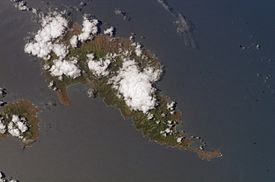Hiva Oa

The island of Hiva Oa. Atuouna is located on the large bay on the south side of the island.
|
|

Location of Hiva Oa within the Marquesas Islands
|
|
| Geography | |
|---|---|
| Location | South Pacific Ocean |
| Coordinates | 9°45′S 139°00′W / 9.750°S 139.000°WCoordinates: 9°45′S 139°00′W / 9.750°S 139.000°W |
| Archipelago | Marquesas Islands |
| Area | 316 km2 (122 sq mi) |
| Highest elevation | 1,213 m (3,980 ft) |
| Highest point | Temetiu |
| Administration | |
| Overseas country | French Polynesia |
| Demographics | |
| Population | 2,190 (2012) |
| Pop. density | 6.9 /km2 (17.9 /sq mi) |
With its 320 square kilometres (124 square miles), Hiva Oa is the second largest island in the Marquesas Islands, in French Polynesia, an overseas territory of France in the Pacific Ocean. Located at 9 45' south latitude and 139 W longitude, it is the largest island of the southern Marquesas group. Around 2,200 people reside on the island. A volcano,Temetiu, is Hiva Oa's highest point with 1,200 metres (3,937 feet).
According to local religion, the gods created the Marquesas as their home. Therefore, all islands have names that are related with the building of a house - Hiva Oa means long ridgepole.
Administratively, Hiva Oa is part of the commune (municipality) of Hiva-Oa, itself in the administrative subdivision of the Marquesas Islands. Atuona, on the coast of Hiva Oa island, is the administrative centre of the commune. Atuona was formerly the seat of government for all of the Marquesas Islands, but it has been replaced by Taiohae on Nuku Hiva island.
The island is famous as the final home of French painter Paul Gauguin and Belgian singer Jacques Brel, both of whom are buried in Calvary Cemetery, overlooking Atuona. It is also home to the largest tiki sculptures in French Polynesia.
In late pre-European times, the island was nearly evenly divided into two provinces—Nuku in the west, and Pepane in the east.
Hiva Oa is the largest and most fertile of the southern Marquesas islands and second only to Nuku Hiva in size. Similar to all the larger Marquesas, Hiva Oa features steep cliffs abruptly rising from the ocean to a rugged interior spine of volcanic mountains, ridges, and deep, isolated valleys. Unlike most other Polynesian islands near the equator, no fringing coral reefs protect Hiva Oa from the pounding of the ocean and only a few sheltered anchorages and sandy beaches are scattered around the coast. Travel along the shoreline is by boat as most of the coastal terrain is too rugged for roads. A few dirt roads traverse the interior and link seacoast villages and settlements.Atuona Airport is located at an elevation of 1,481 feet (451 m) on a plateau near the center of the island and has an asphalt-surfaced runway 3,986 feet (1,215 m) long with daily flights to other Marquesas islands and Tahiti.
...
Wikipedia
